
E-mail: font@focusonnature.com
Phone: Toll-free in USA 1-888-721-3555
or 302/529-1876
Website: www.focusonnature.com
 |
PO Box 9021,
Wilmington, DE 19809, USA E-mail: font@focusonnature.com Phone: Toll-free in USA 1-888-721-3555 or 302/529-1876 Website: www.focusonnature.com |
A
Focus On Nature Tour
in
ESTONIA
For Birds, Butterflies, and Bears,
and other Mammals,
and an assortment of Orchids
and Plants
Thus, a Wonderful Nature
Tour
in a Scenic & Wild Land.
June 13-20, 2016
Tour
with Armas Hill,
to be led by expert local Estonian guides
Itinerary
follows below
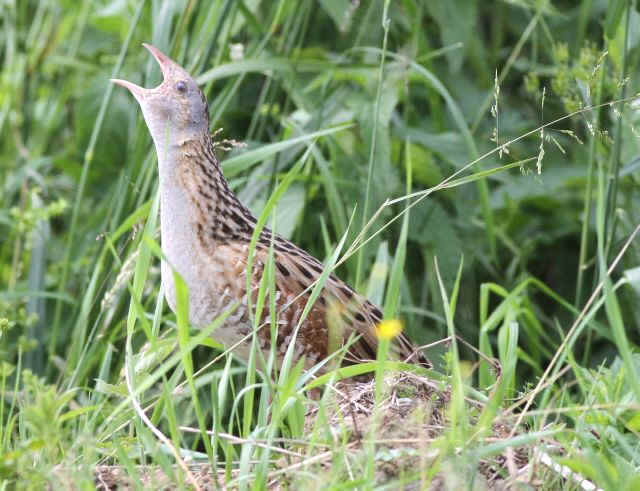
A Corncrake
In June, BIRDS to be
found in Estonia can include:
Corncrake, Western Capercaillie, White-tailed Eagle,
Lesser Spotted Eagle, Willow Grouse, Jack Snipe,
Common Crane, Penduline Tit, Citrine Wagtail.
Also Barred, Booted, and other Warblers.
In the evening & after dark, Great Snipe, European Nightjar,
and various owls, maybe even the Great Grey.
June is an excellent time in Estonia for interesting BUTTERFLIES, including:
Frigga's Fritillary, Bog Fritillary, Lapland Ringlet, Woodland Brown,
Cranberry Blue, Eastern Baton Blue, Poplar Admiral,
Large Checkered Skipper, Olive Skipper, and hopefully Clouded Apollo.
Among the MAMMALS we could see during this tour in Estonia are:
Raccoon Dog, Roe Deer, Red Deer (known in North America as Elk),
Red Fox, European Beaver, Elk (known in North America as Moose),
Siberian Flying Squirrel, European Pine Marten, European Badger,
Ringed Seal,
Wild Boar, Brown Bear, Eurasian Lynx, and Gray Wolf.
We'll do a special excursion to see the bear,
where also we may see the wolf.
June is a good time in Estonia to see interesting PLANT-LIFE,
including a number of ORCHIDS.
36 different orchid species can be found in western Estonia.
Among the plants where we will be:
the Baltic Orchid, Fen Orchid, Lady's Slipper and Red Helleborine,
Lesser Twayblade, Narrow-leaved Marsh-Orchid, Siberian Iris,
and Bird's-eye Primrose, all blooming in their glory.
Links:
A Photo Gallery of Estonian Scenery & Nature
A List & Photo Gallery of European Birds, in 2 Parts:
Part #1: Grouse to Puffin Part
#2: Sandgrouse to
Buntings
Butterflies & Moths of Europe Mammals of Europe
A Photo Gallery of Estonian Orchids & Other Plants
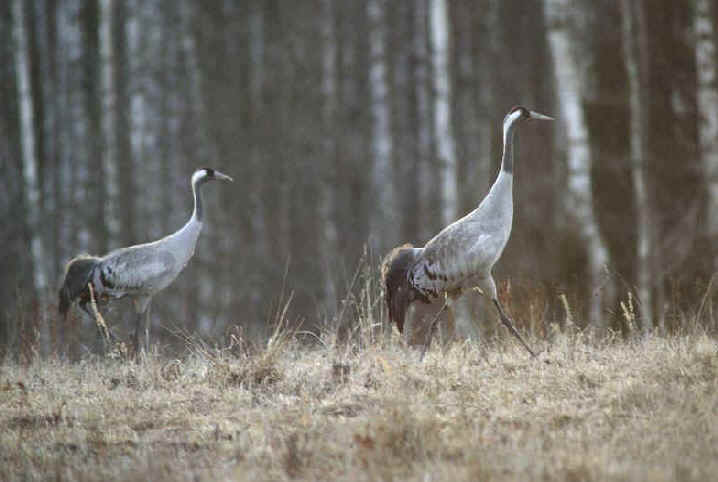
Common Cranes in Estonia
Itinerary:
Mon, Jun 13:
Our tour begins at the Tallinn Airport in
Estonia. From there, we'll go to West Estonia.
Along the way, before the guesthouse where we'll stay, we'll go to a observation
tower where we'll see birds and also Elk (known in North America
as Moose).
Our hotel will be near the sea, and we'll see a number of seaside birds there.
Among them, White-tailed Eagles, cranes, swans, and waders
(or, as known in North America, shorebirds). During our first day, we
should have, already, some interesting sightings.
Tue, Jun 14:
This morning, we'll drive to Dirhami Port for the crossing to Osmussaar
Island, in extreme northwest Estonia, where we'll spend the day.
Osmussaar is unique for its interesting
nature and history - the island was first inhabited by Estonian Swedes, and
later it became a base of the Soviet army. The island of 5 kilometers long and
1.6 kilometers wide. Its highest spot is 8 meters above sea level.
The island is thought to have risen from sea some 3,000 years ago. The landscape
is characterized by its limestone bluff, breccia boulders, vast shingle mound
areas and juniper scrubland.
On the island is a stone chapel, a cemetery, and a lighthouse.
Osmussaar Island is noted for its many orchid
species. There's a total of 16 of them. In mid-June: Early Marsh
Orchids, Military Orchids, Fly Orchids, Common Twayblades and the attractive
Rosa makalis.
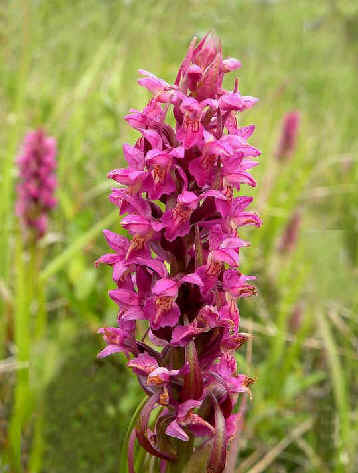
Dactylorhiza incarnata,
the Early Marsh Orchid
For its small size, Osmussaar
Island has a large variety of habitats. "Alvar" (a
thin layer of soil covering limestone plains) covers a good part of the
island.
Butterflies of the "Alvar" include: Scarce and Chestnut
Heaths and Amanda's Blue.
Breeding birds at Osmussaar include
the Black Grouse, Great Bittern, Western Marsh Harrier, Common Crane,
Corncrake, Dunlin, both Common and Arctic Terns, Red-backed
Shrike, and the Barred Warbler.
Wed, Jun 15:
This day, we cross to one of the two large islands of the Estonian Baltic Sea,
island of Hiiumaa.
Over 400 million years ago, an archipelago of tens of kilometers in width was
created near Kardia, the capital of Hiiumaa, as a result of a meterorite
explosion.
These were the first islands at the current location of Hiiumaa, and going back
that 400 million years, makes it one of the oldest islands in the world.
The coast of Sweden is 250 kilometers to the west, and the coast of Finland is
120 kilometers to the north.
Hiiumaa is located in an area where coniferous forest is replaced by broadleaf
forest.
On Hiiumaa, the mixed landscape is forest with both spruce and juniper, with
also swampy broadleaf forest, pine forest, coastal meadows and dunes, bogs and
fens.
Hiiumaa has the most forest of the Estonian
counties. About 70 per cent of the island is covered in forest.
Nesting birds in the area include Thrush-Nightingale and Icterine
Warbler.
The biodiversity on Hiiumaa is significant. There are about 1,000 species of
taller plants. More than 50 of the plant species are protected, for
example: European Yew, Common Ivy, Sea Holly, and Allseed.
In the waters around
Hiiumaa, Ringed Seals and Gray Seals gather. That is
remarkable for the Baltic.
Important bird migration routes pass through Hiiumaa.
First, we'll visit the Kaina-Kassari area.
It has impressive natural communities of alvars, junipers, and sandy meadows
with trees.
Among the plants: Kidney Vetch (Anthyllis coccinea), Wild Orchid (Dactylorhiza
baltica), Brookweed (Samolus valerandi), Small Scabious (Scabiosa
columbaria), and the rare Swamp Angelica (Angelica palustris).
Kaina Bay is one the most best areas of
Hiiuma for a diversity of bird species.
Next, we will go to the Kopu Peninsula,
where more than 80 rare species of plants have been found, including: Ghost
Orchid, Lesser Twayblade, Narrow-leaved Marsh-Orchid, Fen Orchid, Burnt Orchid,
Frog Orchid, and the attractive Twinflower.
Hiiumaa is a very good place to see butterflies
such as the Geranium Argus, Eastern Baton Blue, Cranberry Blue, and the Nickert's
Fritillary.
At Saaremae, in the afternoon, we have a
good chance to see Red Deer (called Elk in North America).

A lighthouse
at Saaremaa with a distant Great Cormorant colony
Thu Jun 16:
Saaremaa Island is one of the
thousand places to be visited before death as recommended in the New York Times
bestseller "1000 Places to See Before You Die", published at the end
of 2011.
Saaremaa is rich with plant species thanks to a soft maritime climate and its
limestone soil. Here, there are 80 per cent of all the plant species that grow
in Estonia. They grow on alvars rich in species, beach meadows, and woodlands of
broadleaf forests.
This day, we'll visit the Viidumae Nature Reserve, located in the highest and
oldest part of the island, with Vidumae forests, marshes, and meadows, where
naturalists first noticed the local plants.
Now, it is known that about 700 vascular plant species are known to be here,
with 59 protected and rare plants among them.
The nature reserve, which was established more than 50 years ago, has now been
researched thoroughly and representatives of many different biological groups
have been found.
For example:
675 macrolepidoptera (butterflies & moths) including the Nickert's
Fritillary and Woodland Brown,
660 mushroom species,
more than 200 spider species,
91 breeding bird species: among them Common Cranes and Black
Storks, while the
forests have Black, Grey-headed, and Green Woodpeckers,
and more than 230 species of moss and also 230 species of lichen.
Several different types of forests can be visited in Viidumae: swamp forest,
heath pine forest with high trees, as well as alvar and nemoral forests.
The surroundings of Viidumae can be compared to a natural botanical garden.
More than half of the plants on Saaremaa occur only in tiny areas, and many of
them are rare.
Here there exists the famous Saaremaa Yellow Rattle (Rhinanthus osiliensis), the
only plant that grows only in Estonia.
Another rare plant in Viidumae is the Alpine Butterwort (Pinguicula alpina). It
received its name due to its broad leaves which it uses to catch insects. The
plant has been growing in Viidumae since the warm period following the last ice
age.
Other plants include: Davall's Sedge, Tawny Sedge, Brown Bugrush
Fen, Bird's-eye Primrose, Tofield's Asphodel, Marsh
grass-of-Parnassus. Locally, we can find the
Blunt-flowered Rush (Juncus subnoulosus).
Many orchid species grow here: Short-spurred Fragrant Orchid (Gymnadenia
odoratissima), Fen Orchid (Liparis loeselii), Early Marsh Orchid,
Heath Spotted Orchid, and Russian Orchid (Dactylorhiza incarnata, D. maculata, D. russowii),
Marsh Helleborine (Epipactis palustris).
In places, areas are covered with Sweetgale (Myrica gale) and thick patches of
Great Fen Sedge (Cladium mariscus). On occasion, Black Bog-rush (Schoenus
nigricans) may be seen.
The largest of the mammals of Viidumae forests are Elk (or Moose),
Red Deer (or Elk), Wild Boar, and Roe Deer. In the forest, the typical small predator is the
European Pine Marten. There are also badgers and foxes.
Many birds nest in the Viidumae forests, including several species of woodpeckers, the most common of which are the
Black Woodpecker, and the Great
Spotted and Lesser Spotted Woodpeckers.
Also in the forest are Tengmalm's (or Boreal) Owl, Eurasian Tawny Owl, Eurasian
Pygmy Owl, and the European Nightjar.
Northern Ravens and White-tailed Eagles live in the area.
Fri, Jun 17:
Another day at Saaremaa. First,
we'll go to the Sorve Peninsula.
Estonian lepidopterologists have discovered a number of butterflies here,
so the place is a favorite for butterfly enthusiasts.
Later in the day, we'll also look for rare species on the Tagmoisa
Peninsula, where over 500 species of vascular plants grow in a
variety of habitats, including on the alvars, and by many lakes with shallow
water and surrounded by fens. Also, among the plants there, and at the nearby
woodland meadows, among the protected species 7 have recently been entered in
the Red Book of Endangered Species.
This day, we'll be exploring one of the most species-rich ecosystems in Europe,
with up to 76 vascular plants species per square meter!
Among the birds along the coast of Saaremaa,
this day, should be numerous Common Scoters and some Arctic Skuas
(known in North America as Parasitic Jaegers).
In the shallow waters, there should be a variety of different waders (or shorebirds).
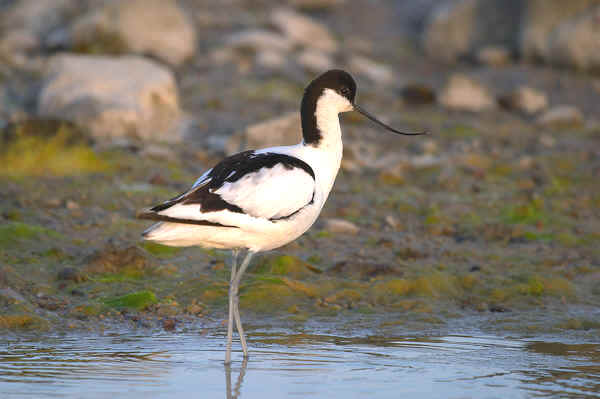
A wader in Estonia is the Pied Avocet
Late this day, we'll journey southward, to be in position for some more birds
& butterflies the following morning.
Sat, Jun 18:
Early this morning, we'll be at Alam-Pedja,
an area of marsh with adjacent forest. it is a truly remote and wild region of
undisturbed floodplains and winding rivers, where it is said that there are only
20 human residents on 260 square miles of wilderness.
Among the birds to be sought: White-backed Woodpecker and Three-toed
Woodpecker, both Greater Spotted and Lesser Spotted Eagles,
and both the Black Woodpecker and the Black Stork.
Residing warblers include: Great Reed, Icterine, Marsh, and Barred.
There will be a number of butterflies that we would not have seen
previously on the islands of Hiiumaa and Saaremaa. These can include: Clouded
Apollo, Bog Fritillary, and Northern Checkered Skipper, as well as
the Baltic Grayling and Scarce Heath.
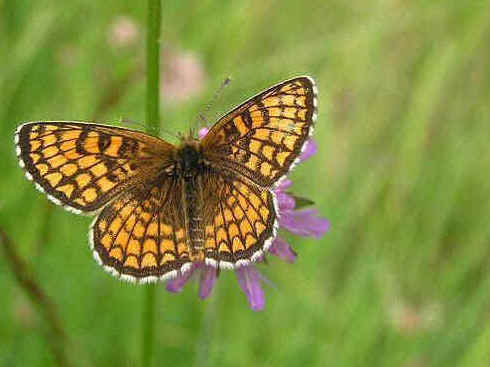
Bog Fritillary
Late in the day, we'll visit the vast expanses of wetlands near
Aardia. This area of lakes and ponds normally holds a good selection
of waterbirds, and other types of birds, such as the Citrine Wagtail,
are possible. As are, again, Spotted Eagles.
In one area, we can watch Wild Boars at a feeding place, and displaying Great
Snipe at one of their best lekking sites in the Baltic
region.
Sun, Jun 19:
This day, we'll go to the richest area in Estonia for bears, the forest of
Alutaguse.
Alutaguse is the largest forested area in Estonia, covering the entire
northeastern part of the country. For those who know something of Estonian
nature, Alutaguse associates with an aura of mystery.
The swamps here are large, and in them, Willow Grouse and Jack Snipe nest, not
doing so elsewhere in Estonia.
Alutaguse is a place for the Siberian Flying Squirrel, which occurs only in
Estonia and Finland, and no where else in Europe.
But again, nowhere else in Estonia are there as many Brown Bears as in Alutaguse.
And, of course, many other animals, such as the Elk (or Moose), Gray
Wolf, Eurasian Lynx, and Eurasian Otter.
And birds, such as the Western Capercaillie, Black Grouse, and Golden
Eagle.
The area is Estonian taiga, but with a central European accent - with also
broadleaf forests and swamps.
The senses are always ready to meet with something extraordinary when moving
around Alutaguse. it can be a bear or
a flying squirrel, but there's a chance for something even more exciting
like a Great Grey Owl and other species of more easterly or northern
habitat, such as the Wolverine, or birds such as the Siberian Jay
or Rustic Bunting.
We'll spend this night at the bear-watching hut where there is a strong
likelihood of seeing a bear, and make an excursion into the habitat of the Brown
Bear to learn about its life. We'll notice the scratched trees, footprints,
bear droppings, and other signs of their presence. We'll learn about their
biology and behavior, and get a touch of local bear folklore during the evening
before we go to the bear-watching hut.
At the hut, we'll quietly take our positions and wait, because the time for
telling tales will be over. The bear's senses are extremely acute,
and its fear of humans is so strong that it would run away in panic in the case
of even the slightest disturbance. We have to be especially careful at nightfall
and at sunrise as that's when bears are particularly active. We'll leave
the bear-watching hut at 8 o'clock the following morning.
A few words about the bear-watching hut: It accommodates 10 people.
Similar to its Finnish and Swedish counterparts, it has comfortable chairs for
observation, bunk beds, and a dry toilet. The bunk beds have sleeping pads, and
each tour participant will be provided with a sleeping bag.
The walls of the hut are soundproof. Our human scents are directed up high into
upper layers of air to keep them from reaching the bears. While waiting for the
bears, we will be served food and drinks.
Generally, about 10 different bears have been sighted near the hut. Also,
at dusk, dawn, and in between, Raccoon Dogs and Gray Wolves
occasionally visit the place.
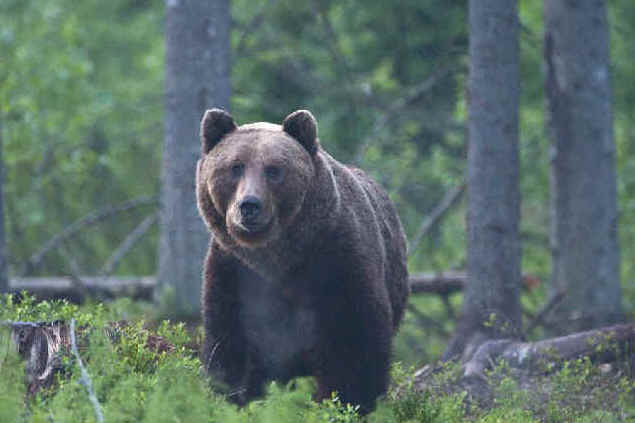
A Brown Bear in an Estonian
forest.
Mon, Jun 20:
We'll take a look around the medieval old town of Taillinn
before going to the airport four our flight home.
It can be said that Tallinn is one of the best and most completely preserved
medieval towns in Europe, and it is a true gem of Estonian
architecture.

Taillinn
Departure from Estonia, with good memories, having seen some extraordinary
nature including good birds, mammals, butterflies, and plants in scenic
countryside.
Price, in US dollars, based on double occupancy:
| $2,395 Single supplement: $295 |
Price includes:
All overnight accommodations and
land transportation within Estonia.
All meals.
Price does not include:
Drinks and other items of
a personal nature.
Flights to/from Estonia.
A deposit of
$500 will assure a
place on the tour.
![]()